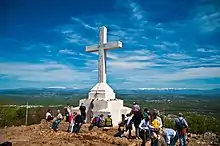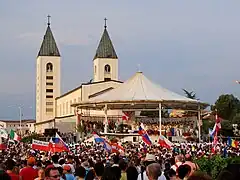Medjugorje
Medjugorje[note 1] (Croatian: Međugorje, pronounced [mêdʑuɡoːrje]) is a village in the municipality of Čitluk, Herzegovina-Neretva Canton of the Federation of Bosnia and Herzegovina, an entity of Bosnia and Herzegovina. Since 1981, it has become a popular site of Catholic pilgrimage due to Our Lady of Medjugorje, a purported series of apparitions of the Virgin Mary, mother of Jesus, to six local children[1] that are supposedly still happening to this day.[2]
Međugorje | |
|---|---|
Village | |
 | |
 Međugorje Location of Međugorje within Bosnia and Herzegovina | |
| Coordinates: 43°12′N 17°41′E | |
| Country | Bosnia and Herzegovina |
| Entity | Federation of Bosnia and Herzegovina |
| Canton | Herzegovina-Neretva |
| Municipality | Čitluk |
| Area | |
| • Total | 11.83 km2 (4.57 sq mi) |
| Population (2013) | |
| • Total | 2,265 |
| • Density | 190/km2 (500/sq mi) |
| Time zone | UTC+1 (CET) |
| • Summer (DST) | UTC+2 (CEST) |
| Website | www.medjugorje.hr |
The name Međugorje literally means "between mountains". At an altitude of 200 m (660 ft) above sea level it has a mild Mediterranean climate. The town consists of an ethnically homogeneous Croat population of 2,306. The Roman Catholic parish includes four neighbouring villages: Bijakovići, Vionica, Miletina and Šurmanci. Since 2019, pilgrimages to Medjugorje have been authorized by the Vatican as long as there is no assumption the events are confirmed to have a supernatural origin.[3][4]
History
Early history
To the east of Međugorje in the Neretva valley, the Serbian Orthodox Žitomislić Monastery has stood since 1566. Destroyed in 1992 by a raiding party sent from Medjugorje it has been reconstructed.[5] Gravestones erected in the Middle Ages have remained to this day in the Catholic cemetery Groblje Srebrenica in the hamlet of Miletina as well as in the hamlet of Vionica.[6] In the area of the cemetery in Miletina, structures from the Roman era stood, whose ruins have not yet been fully excavated.[7]
19th and early 20th centuries
Part of the Ottoman Empire until 1878, it became part of Austria-Hungary (War of 1878, Annexation 1908). In 1882 the railway line between Mostar and the Adriatic coast of Dalmatia was built, with a station in the hamlet of Šurmanci, through which the village gained access to the railway network.
The Catholic parish of Sveti Jakov ("Saint James") was erected in 1892 by the Bishop of Mostar Paškal Buconjić. The twelve-metre tall crucifix on the mountain called Križevac (Cross Mountain), completing the parish's Stations of the Cross (križni put), was completed in 1934.[8][9]
The Medjugorje pilgrimage site
.jpg.webp)
Our Lady of Medjugorje is the title given to the apparition by those who believe that the Virgin Mary, mother of Jesus, has been appearing from 24 June 1981 until today to six children, now adults, in Medjugorje (then part of communist Yugoslavia).[10] The Marian shrine of Medjugorje has become a popular pilgrimages site for Catholics,[11] and has turned into Europe's third most important apparition site, where each year more than 1 million people visit.[12] It has been estimated that 30 million pilgrims have come to Međugorje since the reputed apparitions began in 1981.[13]
In 1981 as soon as reports began of the Marian apparitions on Crnica hill in the Bijakovići hamlet, confrontations with Yugoslav state authorities began. Pilgrims were forbidden from coming,[14] the pilgrim's donations were seized by the police and access to what was called the Apparition Hill was largely blocked. The parish priest of Medjugorje at that time, Father Jozo Zovko, was arrested and convicted of sedition.[15] He refused to follow the orders from the Communist Party headquarters in Mostar: to stop the people from meeting on Podrodo and to stop the evening Mass.[16]
In the last years before the 1992 breakup of Yugoslavia, travel of pilgrims was no longer hindered by the state.[14]
Međugorje during the Bosnian War
During the Bosnian War, Medjugorje remained in the hands of the Croatian Defence Council and in 1993 became part of the Croatian Republic of Herzeg-Bosnia. By the Dayton Agreement in 1995, Medjugorje was incorporated into the Federation of Bosnia and Herzegovina, populated mostly by Bosniaks and Croats. It lies within the Herzegovina-Neretva Canton, one of ten autonomous regions established so that no ethnic group could dominate the Federation.
On 2 April 1995, at the high point of conflict within the local diocese, Bishop Ratko Perić was kidnapped by Croat militiamen, beaten, and taken to a chapel run by one of the Franciscans associated with Međugorje, where he was held hostage for ten hours. At the initiative of the mayor of Mostar, he was freed without bloodshed, with the help of the United Nations Protection Force.[17][18][19]
Development after the war
.jpg.webp)
The town and its environs boomed economically after the war. Over a thousand hotel and hostel beds are available for pilgrims to the town. With approximately one million visitors annually, Medjugorje has the most overnight stays in Bosnia and Herzegovina.
In 2017, Pope Francis appointed Archbishop Henryk Hoser of Praga (Warsaw) as a special envoy of the Holy See to Medjugorje, tasked with assessing its pastoral needs.[20][21] By the end of 2017, Hoser had announced that the Vatican's position was in favor of organizing pilgrimages.[22] In 2018, the Pope named Hoser as an apostolic visitor to Medjugorje, for "an undefined period and at nutum Sanctae Sedis" (at the disposal of the Holy See). The aim of this mission is "ensuring a stable and continuous accompaniment to the parish community of Medjugorje and to the faithful who go there as pilgrims, and whose needs require particular attention."[23][24] In 2019, the Vatican officially authorized pilgrimages to Medjugorje as long as there is no assumption the events are confirmed to have a supernatural origin.[3] The first Vatican-sanctioned pilgrimage then took place for five days from 2-6 August 2019.[4] During the pilgrimage, approximately 60,000 young Catholics from 97 countries took part in the Medjugorje International Youth Festival.[4] Fourteen archbishops and bishops and about 700 Catholic priests joined the festivities as well.[4]
Demographics
According to the 2013 census, its population was 2,265.[25]
| Ethnicity | Number | Percentage |
|---|---|---|
| Croats | 2,232 | 98.5% |
| Bosniaks | 4 | 0.2% |
| Serbs | 3 | 0.1% |
| other/undeclared | 26 | 1.1% |
| Total | 2,265 | 100% |
Notable people
- Marin Čilić – tennis player, winner of the 2014 US Open
- Ivan Dodig – tennis player, winner in doubles of the 2015 French Open
- Andrija Stipanović – basketball player, Bosnia-Herzegovina national basketball team representative
- Vladimir Vasilj – former Croatian football player
Gallery
.jpg.webp) Panoramic of Medjugorje
Panoramic of Medjugorje Cross at Križevac hill
Cross at Križevac hill.jpg.webp) Blue cross at Podbrdo hill
Blue cross at Podbrdo hill_Medjugorje_-_Hotel_Pansion_Porta_-_Bosnia_Herzegovina_-_Creative_Commons_by_gnuckx_(4695237966).jpg.webp) Saint James church
Saint James church_Medjugorje_-_Hotel_Pansion_Porta_-_Bosnia_Herzegovina_-_Creative_Commons_by_gnuckx_(4695293226).jpg.webp) Outdoor altar of Saint James church
Outdoor altar of Saint James church.jpg.webp) Stations of the Cross at Križevac hill
Stations of the Cross at Križevac hill Jesus leaving The Cross, located behind the St. James Church
Jesus leaving The Cross, located behind the St. James Church.jpg.webp) Our Lady statue at Podbrdo
Our Lady statue at Podbrdo
Notes
- "dj" was replaced by "đ" in Gaj's Latin alphabet, but continues to be used in the majority of English-language sources, either by choice or out of typographic limitation.
Footnotes
- Overview of Medjugorje Medjugorje.org, accessed 6 July 2020.
- "For second time, Pope sends special envoy to Medjugorje". Crux. 2018-05-31. Archived from the original on 2019-05-13. Retrieved 2019-05-06.
- Pope authorizes pilgrimages to Medjugorje 12 May 2019, accessed 6 July 2020.
- Vatican confirms Medjugorje approval by joining youth festival Jonathan Luxmoore Aug 7, 2019, accessed 6 July 2020.
- András Riedlmayer: Zitomislici (1566-1992): Meaning, History, and Tragic End, Haverford College, undated, in the Internet Archive
- Franjo Sušac: Stećci Archived 2013-12-08 at the Wayback Machine, Turistička zajednica općine Čitluk, 2002; cf. also Town map Archived 2013-08-22 at the Wayback Machine
- KRATKE POVIJESNE ČINJENICE: (tr. "BRIEF HISTORICAL FACTS") -Presentation of the region's history -website of the Informativni Centar Međugorje accessed 6 July 2020.
- Medjugorje, Description of the town at truepeace.com.au
- Medjugorje auf friedenskoenigin.de
- A short history of Our Lady's apparitions in Medjugorje 14 June 2004, accessed 21 July 2020.
- Australian dies in Bosnia bus crash. Sydney Morning Herald. Retrieved 28 February 2010.
- RomeReports: Visionaries of Medjugorje may appear before the Vatican. Archived 2013-05-05 at the Wayback Machine Retrieved Feb 26 2011.
- Vatican Probes Claims of Apparitions at Medugorje Reuters. Retrieved 17 March 2010.
- Ulrike Rudberg: Abends, wenn Maria kommt. Die Zeit, 26 June 1987.
- Holmström, Leif In cooperation with UNESCO Office International Standards and Legal Affairs, ed. (2019). Cases of the UNESCO Committee on Conventions and Recommendations: Communications examined under the 104 EX/Decision 3.3 Procedure of the Executive Board (1978-1988). Vol. 2. Leiden; Boston: UNESCO (United Nations Educational, Scientific and Cultural Organization). p. 537. ISBN 9789004390294.
- Kengor, Paul (2017). A Pope and a President. Delaware: ISI Books.
- E. Michael Jones: The Ghosts of Surmanci, South Bend, Indiana), February 1998.
- Michael Sells: Crosses of Blood, Sociology of Religion, Wake Forest University, Winston-Salem, Herbst 2003.
- René Laurentin: Medjugorje Testament, Ave Maria Press, Toronto 1998; ISBN 0-9697382-6-9, cited by Craig L. Heimbichner
- Pentin, Edward (11 February 2017). "Pope Francis Appoints Polish Archbishop to Be Special Envoy to Medjugorje". National Catholic Register. Retrieved 11 February 2017.
- "Pope appoints Special Envoy to Medjugorje". Retrieved 2017-06-23.
- Official pilgrimages to Medjugorje are being authorized, confirms Pope Francis’ envoy accessed 6 July 2020.
- News from Medjugorje 26 June 2020, accessed 6 July 2020.
- Holy See Press Office Communiqué: Appointment of Special Apostolic Visitor for the parish of Medjugorje, 31.05.2018.
- Ethnicity/National Affiliation, Religion and Mother Tongue 2019, pp. 392–393.
Bibliography
- Belaj, Marijana (2012). Milijuni na putu - Antropologija hodočašća i sveto tlo Međugorja [The millions of a way - the anthropology of pilgrimage and the holy ground of Medjugorje] (in Croatian). Zagreb: Jasenski i Turk. ISBN 9789532225884.
- Ethnicity/National Affiliation, Religion and Mother Tongue (PDF). Sarajevo: Agency for Statistics of Bosnia and Herzegovina. 2019.
- Margry, Peter Jan (2023). "Conflict or Harmony? Religion and Politics: A Pas de Deux". In Köllner, Tobias; Testa, Alessandro (eds.). Politics of Religion: Authority, Creativity, Conflicts. Oxford: Oxford University Press. ISBN 9780198718383.
- Maunder, Chris (2016). Our Lady of the Nations: Apparitions of Mary in 20th-Century Catholic Europe. Münster: LIT Verlag Münster. ISBN 9783643912763.
External links
- Marian shrine of Medjugorje – Official Website (in English)
- MaryTV – Live streams from Medjugorje (in English)

